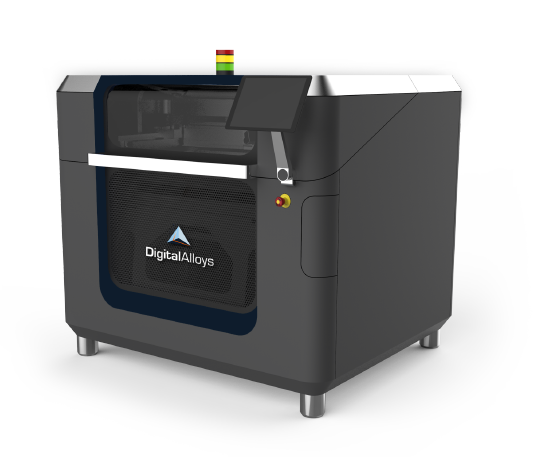Earlier today, Digital Alloys announced a successful $12.9 million Series B funding round. Boeing HorizonX Ventures, Lincoln Electric and Khosla Ventures participated in the round led by G20 Ventures.
Following recent 3D printing investment activity in the region, this announcement illustrates a second wave of metal 3D printing enterprises centered around Boston that keep getting stronger and have the attention of investors.
3D Printing Industry caught up with Digital Alloys’ CEO Duncan McCallum to learn more about the patented Joule Printing system that is now claimed to be the highest density and strength metal additive manufacturing option.
3D Printing Industry: What is Joule Printing and what are the advantages over other metal additive manufacturing techniques?
Duncan McCallum, Digital Alloys: Joule Printing was created to free manufacturers from the shackles of slow, complicated and expensive metal 3D printing. Joule Printing is a technology that is radically simple and amazingly fast, and that offers dramatically low production costs.
You can see a detailed description of Joule Printing, with some videos, online.
Joule Printing™ uses commodity wire as the raw material rather than expensive powders. The technology is a radically simple, high speed process for melting wire into useful shapes that works as follows:
Rapid, precise motion and wire feed systems position the tip of the wire in contact with a desired printing (melting) location.
Once the wire is positioned, the system pushes current through the wire and part being printed and into the print bed. The current melts the wire tip using joule heating (aka “resistance heating”), the same physics that heat a coil in a toaster.
Melting and wire feed continue while the print head moves, laying down beads of metal which are fused together to form fully dense metal parts.
Advantages:
The positioning and melting of the wire occur simultaneously in a single step. This radical simplicity lowers cost, saves time, and increases repeatability. There is no need for powder handling, feeding and spreading, no need for binding/debinding, and no need for sintering – and no need for the costs, time delays and variability these steps introduce.
Wire is dramatically less expensive than metal powder, and broadly available.
Joule heating is the most efficient way to convert electrical energy into heat. Because the wire melts from within, there is no wait for heat to move to where it’s needed. Melting occurs instantly, exactly at the desired location. This allows ridiculously fast printing speeds. Our first system leverages this to print at 5‑10kg/hour at very low power (<1 kWh per kg).
Joule Printing™ provides precise closed-loop control of melting at the voxel level. This allows the system to deliver consistently dense (99.5%+) isotropic parts that are stronger than castings.
3D Printing Industry: Bill Wiberg, co-founder and Partner of Boston-based G20 Ventures, said earlier, “you have to wonder why anyone would do it any other way” why have others not taken this approach?
Duncan McCallum: Great question. We are the inventors of Joule Printing, and have two issued patents (so far) that will block others from using this unique process.
3D Printing Industry: Is the Joule Printing method more suited to a particular application, i.e. intricate medical models or larger structural parts in aerospace for example?
Duncan McCallum: Joule Printing is most useful for applications where production cost and the quality of metal (strength, density) printed are important. Key initial applications we have developed with customers include conformally cooled tools for the automotive and consumer products industries, and high-quality, cost-reduced titanium parts for aerospace and defense. We have orders from about a dozen companies across these three industries.

3D Printing Industry: Information on the Digital Alloys’ website says that 99.5% dense isotropic parts can be produced. What else can you say about the density of metal parts produced with your system, how does this compare to other metal AM processes?
Duncan McCallum: Today we are printing metal that is 99.5%+ dense, and that has the same tensile strength as wrought metal. Importantly, these properties are attained with NO post processing (heat treatment, or HIP’ing).
We are printing the highest density and strength in the industry.
3D Printing Industry: We understand that shipping of the system was planned for this year, is this still the case and what is the price?
Duncan McCallum: We are launching as a provider of production quality 3D printed parts. We will begin shipping parts to customers this fall.
We will begin printer sales next year. Date and pricing not yet announced.
3D Printing Industry: How will Lincoln Electric be involved?
Duncan McCallum: We have not announced the details of our partnership with Lincoln Electric. For now, I can say that Lincoln has a broad set of capabilities in technology, distribution, and services that fit well with Digital Alloys’ product and business plans, and we are very excited about what the partnership brings to Digital Alloys.

More information about Digital Alloys is available here.
Get all the latest 3D printing news direct to your inbox, subscribe to the free 3D Printing Industry newsletter. Also, follow us on Twitter, and like us on Facebook.
Looking for a change of pace? Seeking new talent for your business? Search and post 3D Printing Jobs for opportunities and new talent across engineering, marketing, sales and more.



